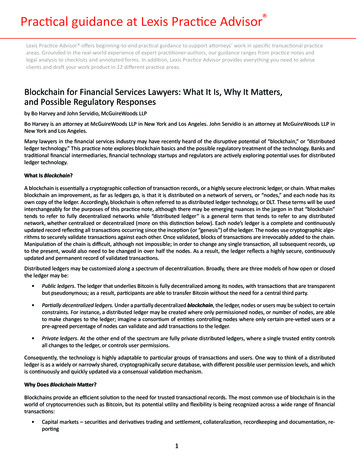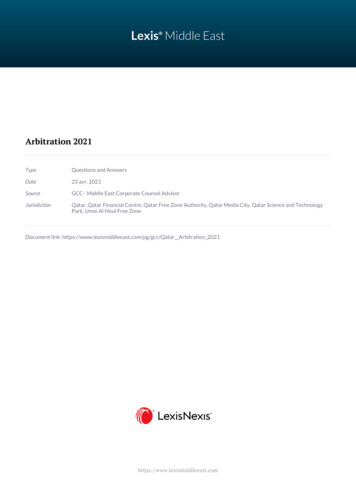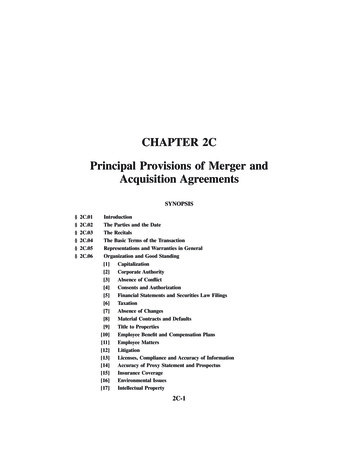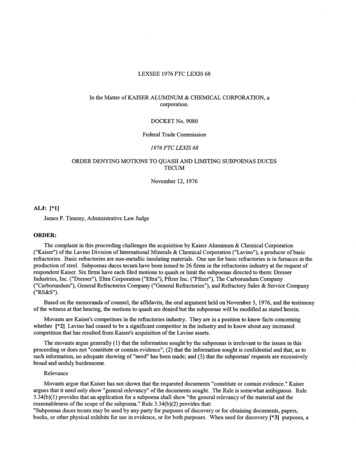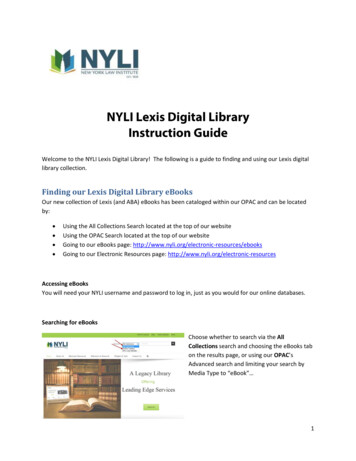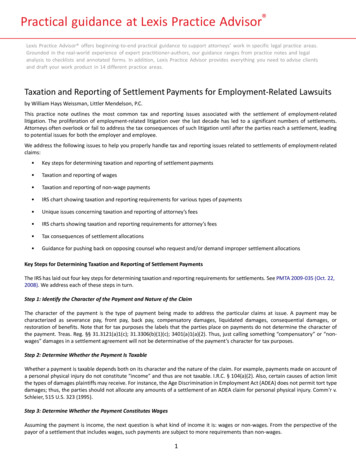
Transcription
Practical guidance at Lexis Practice Advisor Lexis Practice Advisor offers beginning-to-end practical guidance to support attorneys’ work in specific legal practice areas.Grounded in the real-world experience of expert practitioner-authors, our guidance ranges from practice notes and legalanalysis to checklists and annotated forms. In addition, Lexis Practice Advisor provides everything you need to advise clientsand draft your work product in 14 different practice areas.Taxation and Reporting of Settlement Payments for Employment-Related Lawsuitsby William Hays Weissman, Littler Mendelson, P.C.This practice note outlines the most common tax and reporting issues associated with the settlement of employment-relatedlitigation. The proliferation of employment-related litigation over the last decade has led to a significant numbers of settlements.Attorneys often overlook or fail to address the tax consequences of such litigation until after the parties reach a settlement, leadingto potential issues for both the employer and employee.We address the following issues to help you properly handle tax and reporting issues related to settlements of employment-relatedclaims: Key steps for determining taxation and reporting of settlement payments Taxation and reporting of wages Taxation and reporting of non-wage payments IRS chart showing taxation and reporting requirements for various types of payments Unique issues concerning taxation and reporting of attorney’s fees IRS charts showing taxation and reporting requirements for attorney’s fees Tax consequences of settlement allocations Guidance for pushing back on opposing counsel who request and/or demand improper settlement allocationsKey Steps for Determining Taxation and Reporting of Settlement PaymentsThe IRS has laid out four key steps for determining taxation and reporting requirements for settlements. See PMTA 2009-035 (Oct. 22,2008). We address each of these steps in turn.Step 1: Identify the Character of the Payment and Nature of the ClaimThe character of the payment is the type of payment being made to address the particular claims at issue. A payment may becharacterized as severance pay, front pay, back pay, compensatory damages, liquidated damages, consequential damages, orrestoration of benefits. Note that for tax purposes the labels that the parties place on payments do not determine the character ofthe payment. Treas. Reg. §§ 31.3121(a)1(c); 31.3306(b)(1)(c); 3401(a)1(a)(2). Thus, just calling something “compensatory” or “nonwages” damages in a settlement agreement will not be determinative of the payment’s character for tax purposes.Step 2: Determine Whether the Payment Is TaxableWhether a payment is taxable depends both on its character and the nature of the claim. For example, payments made on account ofa personal physical injury do not constitute “income” and thus are not taxable. I.R.C. § 104(a)(2). Also, certain causes of action limitthe types of damages plaintiffs may receive. For instance, the Age Discrimination in Employment Act (ADEA) does not permit tort typedamages; thus, the parties should not allocate any amounts of a settlement of an ADEA claim for personal physical injury. Comm’r v.Schleier, 515 U.S. 323 (1995).Step 3: Determine Whether the Payment Constitutes WagesAssuming the payment is income, the next question is what kind of income it is: wages or non-wages. From the perspective of thepayor of a settlement that includes wages, such payments are subject to more requirements than non-wages.1
Practical guidance at Lexis Practice Advisor We provide more detail on tax and reporting requirements for both wage and non-wage payments in the sections below entitledTaxation and Reporting of Wages and Taxation and Reporting of Non-wage Payments.Step 4: Determine the Proper Reporting for Attorney’s FeesIn general, attorney’s fees are income to both the party receiving payment and the attorney receiving payment. Further, there areissues relating to whether the recipients of such income are entitled to deductions for paying attorney’s fees, and the proper reportingof such fees. We provide more detail on tax and reporting requirements for attorney’s fees payments in the section below entitledUnique Issues Concerning Taxation and Reporting of Attorney’s Fees.Taxation and Reporting of WagesWhen a payment is treated as wages, it is generally subject to federal and state income tax withholding (if the applicable state hasan income tax), Social Security taxes, Medicare taxes, federal and state unemployment taxes, and any other state employment taxes,such as disability insurance taxes. The wages and withholdings are reported on IRS Form W-2.All payments of wages are treated as wages subject to employment taxes unless specifically exempted. Courts and taxing agenciesclassify severance pay as wages. As explained in more detail below, with limited exceptions, courts and taxing agencies also classifyback pay and front pay damages as wages. Below we also discuss the inconsistent classification of amounts paid under the Family andMedical Leave Act (FMLA) and payments pursuant to claims based on failure or refusal to hire.Back PayBack pay is compensation that constitutes the difference between the pay the employee received and the pay to which the employeewas legally entitled to receive up to the time of the settlement date. No statute or regulation exempts back pay from the definitionof wages for tax purposes. I.R.C. § 3401; United States v. Cleveland Indians Baseball Co., 532 U.S. 200 (2001). This is true even if theworkers receiving the payments are no longer employed by the payor for other purposes at the time the payment is made. Treas.Reg. § 31.3401(a)-1(a)(5).The U.S. Supreme Court has held that back pay awarded under the National Labor Relations Act to an employee whose employer hadwrongfully discharged him was “wages” under the Social Security Act. Social Security Bd. v. Nierotko, 327 U.S. 348 (1946). The Courtstated that the back pay constituted remuneration and also held that the remuneration was for “employment” even though the backpay related to a period during which the petitioner did not perform any service. Nierotko, 327 U.S. at 365–66. Several courts dealingwith whether payments upon settlement of claims constituted wages for employment tax purposes have cited Nierotko. See, e.g.,Mayberry v. United States, 151 F.3d 855 (8th Cir. 1998); Hemelt v. United States, 122 F.3d 204 (4th Cir. 1997).The exception to the general rule that back pay constitutes wages is when the employee receives back pay on account of a personalphysical injury or illness. See, e.g., Johnson v. United States, 76 Fed. Appx. 873 (10th Cir. 2003).Front PayFront pay is compensation for an employee that he or she would have received after the settlement date had the employer notallegedly engaged in prohibited conduct (i.e., future lost earnings). Front pay has been subject to less litigation than back pay.Nonetheless, the limited authority appears to support treating front pay as wages. For example, a federal district court in New Jerseyheld that both back pay and front pay paid as part of a settlement award to a former employee were wages and thus subject to federalemployment taxes. Josifovich v. Secure Computing Corp., 2009 U.S. Dist. LEXIS 67092 (D.N.J. July 31, 2009). The court found that“because the Supreme Court in Nierotko held that services performed—a component of the definition of wages, which are subjectto withholding—encompasses the entire employee-employer relationship and not merely the work actually performed, this Courtconcludes that front pay, like back pay, is subject to withholding taxes.” Josifovich, 2009 U.S. Dist. LEXIS 67092, at *12–13.However, the Fifth Circuit ruled that front pay is not wages because it represents a “‘loss in earning capacity,’ not for services alreadyperformed.” Dotson v. United States, 87 F.3d 682, 690 (5th Cir. 1996). Thus, courts are not entirely consistent in their treatment offront pay. However, outside the Fifth Circuit, it would not be advisable to treat front pay as other than wages for tax purposes.Amounts Paid under the Family and Medical Leave Act (FMLA)Courts and taxing agencies generally treat amounts paid under the Family and Medical Leave Act (FMLA) as wages. However, courtsin the Eastern District of Pennsylvania have held that based on the peculiar language of the FMLA—which creates a remedy ofdamages equal to the amount of denied or lost wages (see 29 U.S.C. § 2617(a))—amounts paid under the FMLA are not for services2
Practical guidance at Lexis Practice Advisor in employment but rather for damages that are simply equivalent to the amount of denied or lost wages, and as such are notthemselves wages for tax purposes. Carr v. Fresenius Med. Care, 2006 U.S. Dist. LEXIS 29627, at *8 (E.D. Pa. 2006); Churchill v. StarEnterprises, 3 F. Supp. 2d 622 (E.D. Pa. 1998). The IRS, however, does not appear to subscribe to this view. Thus, the IRS generally willconsider amounts paid under the FMLA as wages for tax purposes.Refusal to Hire CasesThe IRS has stated that claims based on failure or refusal to hire are back pay and thus wages. Rev. Rul. 78-176. A federal district courtin the Southern District of New York cited Rev. Rul. 78-176 with approval in Melani v. Board of Higher Ed., 652 F. Supp. 43 (S.D.N.Y.1986), aff’d, 814 F.2d 653 (2d Cir. 1987).However, the Eighth Circuit has held differently, finding that Federal Insurance Contributions Act (FICA) tax (i.e., federal payroll tax)and income tax withholding do not apply unless an actual employer-employee relationship existed, and no such relationship existedwhen an employer failed to hire an individual. Newhouse v. McCormack, 157 F.3d 582 (8th Cir. 1998). Parties that settle failure to hireclaims in the Eighth Circuit may treat the settlement as other than wages; otherwise, the IRS would likely take the position that theparties should allocate the settlement to wages.Taxation and Reporting of Non-wage PaymentsUnlike wages, non-wage payments are not subject to tax withholding by an employer, although they are usually income to therecipient, and thus taxable for income tax purposes. If the amount paid is 600 or more, the employer must report the amount onIRS Form 1099-MISC, in box 3. The exception is for interest paid by an employer, which if 600 or more, gets reported on IRS Form1099-INT.Below we provide more detail on the following types of non-wage payments: Personal physical injuries or illness Emotional distress Tax treatment of liquidated damages and interest Incentive payments to named class representatives Interest Liquidated damages Employment law penalties claimed by employees in litigationPersonal Physical Injuries or IllnessUnder I.R.C. § 104(a)(2), amounts received from personal physical injury or illness are not income subject to tax. The IRS has definedpersonal physical injury or sickness as requiring an “observable bodily harm” such as bruising, cuts, swelling, and bleeding. See I.R.S.Priv. Ltr. Rul. 200041022 (July 17, 2000). Payments on account of personal physical injuries are not reported.Amounts Received Due to Emotional DistressBefore 1996, the IRS and courts generally treated emotional distress as falling within the exemption under I.R.C. § 104(a)(2). However,for payments made after August 21, 1996, emotional distress was expressly carved out of I.R.C. § 104(a)(2). Emotional distressincludes psychological distress and the physical symptoms of the emotional distress, such as stomachaches, ulcers, and headachestriggered by emotional distress. Conference Committee Report to the 1996 Act (August 1, 1996)—104 H. Rpt. 737. When consideringsettlements of claims, you must understand that emotional distress is taxable income. Emotional distress damages are reported onIRS Form 1099-MISC, box 3 (other income) if over 600. But emotional distress is not taxable up to the amount of any unreimbursedmedical expenses that the plaintiff paid. Therefore, it is helpful to know if any such offsets exist when negotiating a settlementagreement.Emotional distress damages, while taxable income, are not wages, as they are not intended to take the place of wages employerspay to employees. We are not aware of any cases, revenue rulings, or other guidance that has treated emotional distress as wagessubject to employment taxes.3
Practical guidance at Lexis Practice Advisor Rather, the IRS’s instructions to the Form 1099-MISC expressly state:Other items required to be reported in box 3 [of IRS Form 1099-MISC, for other income] include the following.1.Generally, all punitive damages, any damages for nonphysical injuries or sickness, and any other taxable damages.Report punitive damages even if they relate to physical injury or physical sickness. Generally, report allcompensatory damages for nonphysical injuries or sickness such as employment discrimination or defamation.However, do not report damages (other than punitive damages):a.Received on account of personal physical injuries or physical sickness;b.That do not exceed the amount paid for medical care for emotional distress;c.Received on account of nonphysical injuries (for example, emotional distress) under a written bindingagreement, court decree or mediation award in effect on or issued by September 13, 1995. . . .Damages received on account of emotional distress, including the physical symptoms such as insomnia, headaches,and stomach disorders, are not considered received for a physical injury or physical sickness and are reportable unlessdescribed in b or c above. However, damages received on account of emotional distress due to physical injuries orphysical sickness are not reportable.Also, report liquidated damages received under the Age Discrimination in Employment Act of 1967.2017 Form 1099-MISC Instructions, p. 5 (emphasis added). In sum, treat payments for emotional distress as taxable income but notwages.Incentive Payments to Named Class RepresentativesNamed plaintiffs in a class or collective action (class representative) sometimes receive an additional incentive payment to compensatethem for the risk of being the class representative and participating in the litigation. There is very little authority concerning the taxtreatment of such incentive payments. We address this limited authority below.Trotter v. Rankin: Payments to Class Representatives Constitute Taxable WagesA Delaware federal district court held that incentive payments made to eight class representatives were wages subject to employmenttaxes. Trotter v. Rankin, 253 F. Supp. 2d 812 (D. Del. 2003). Trotter involved a typical employment-related class action, in which theplaintiffs sought back pay and certain benefits. The parties entered into a settlement agreement that allocated the settlement basedon hours worked and years of service. In addition, each of the eight named plaintiffs received a 5,000 incentive payment for the riskof being class representatives.The parties sought an order from the court regarding the proper tax treatment of the incentive payments. Plaintiffs asserted thatthe class representatives did not render services to the employer but to the class, which would usually be adverse to the employer.Plaintiffs contended that the payments would thus not be “remuneration for employment” within the meaning of the InternalRevenue Code (Code). The defendants argued that the underlying claims in this case were for back wages, that there was no claim bythe named plaintiffs for services provided to the class members, and that the court should therefore consider the 5,000 paymentsas wages.The court began its analysis by noting that the definition of wages and employment are both very broad, citing to well-establishedprecedents and the Code. It noted that the parties conceded that there were no cases, rulings, or other IRS guidance on the issue.(This appears to remain true today, as, other than Trotter, we have not found such guidance, rulings, or cases.) The court focusedprimarily upon a private letter ruling, stating:In Priv. Ltr. Rul. 2003-03-003 (Jan. 17, 2003), a settlement agreement was reached following a class action suitbased on employment discrimination for back pay, other lost compensation, and various other damages. The allocationof damages stipulated in the settlement agreement was based on various economic considerations, including workperformed on the class action lawsuit. Although the settlement agreement stated that all payments made representedcompensatory damages and not wages, the IRS concluded that this statement was inconsistent with the economicsubstance of the settlement. The ruling determined that the underlying cause of action and the calculation of damages inthe settlement agreement were based solely on economic considerations and that the underlying claim was a “wagebased claim.” Furthermore, the ruling concluded that the settlement agreement specifically allocated payments basedon economic factors, such as, lack of promotions, lack of wage increases, undeserved discipline and work on the class4
Practical guidance at Lexis Practice Advisor action lawsuit, inter alia. Additionally, the number of years of service [was] a factor in determining the amount of thepayment to each member of the class. (emphasis added).The ruling held that the entire payment was remuneration for services and constituted wages subject to withholdingtaxes. Id.Trotter, 253 F. Supp. 2d at 817.The court stated that “the 5,000 incentive payment to the Class Representatives was not specifically characterized in the Plan ofAllocation.” Trotter, 253 F. Supp. 2d at 818. It went on to explain:As outlined above, various courts and the IRS have looked to the nature of the underlying claim to determine whetherpayments in a settlement are to be considered “wages.” Plaintiffs, themselves, have stated that this is a “wage case inwhich Class Members will receive payments characterized as back-wages.” Analogous to Priv. Ltr. Rul. 2003-03-003discussed previously herein, the settlement agreement in the instant case specifically allocated payments based oneconomic factors. Included in the economic factors described in Priv. Ltr. Rul. 2003-03-003 were payments to ClassMembers based on hours worked, years of service, and “work on the class action lawsuit.” The ruling determined thatthe entire payment was remuneration for services and constituted wages subject to withholding taxes. Id. Pursuant tothe Plan of Allocation in this case, the amount received by each Class Member, including the Class Representatives, isbased on hours worked and years of service. The Class Representatives would not have received any payments if theyhad not been employed and met the requirements of one of the classes outlined in the Plan of Allocation. Id. Theirservices are an integral component of the “entire employer-employee relationship.” See Soc. Sec. Bd. v. Nierotko, 327U.S. at 365.Furthermore, all parties agreed during the Final Fairness Hearing, that the settlement award was to be in the aggregatewith the determination of the allocation to occur according to the Agreement. Similarly, in the examples in Rev. Rul. 80364, the settlement had not been specifically allocated, but the underlying claims were wage-based and the awardwas considered income and wages.Given that the Agreement allocated payments based on economic factors, the nature of the underlying claims is to beconstrued as wage-based, and the award is for remuneration for services and thus subject to withholding.Id. (citations to the record omitted).The court in Trotter based its decision in part upon the facts that: The only underlying claim was one for wages The Allocation Plan did not specifically allocate these payments separately Plaintiffs had not made any claim in the complaint for a separate payment –and– The parties based the allocation on economic factors that could have included work on the lawsuitWhether a court would come to the same result when faced with a different fact pattern is not known.Post-Trotter IRS Chief Counsel Advice Memorandum: Payments to Class Representatives Are Taxable WagesIn a subsequent IRS Chief Counsel Advice Memorandum, the IRS cited to Trotter favorably, concluding that incentive payments toclass representatives “represent remuneration arising from the employment relationship and there is no exception from wages thatapplies to these payments.” IRS Chief Counsel Advice Memorandum 201311022 (Aug. 10, 2012)—2012 IRS CCA LEXIS 252.InterestThe IRS does not treat interest payments as wages subject to employment taxes, but it treats interest payments as taxable income.See 2017 Form 1099-INT (interest income); Rev. Rul. 80-364 (July 1980) (interest is not wages subject to employment taxes).Liquidated DamagesLike interest payments, the IRS and courts treat liquidated damages as taxable income but not as wages. See, e.g., 2017 Form 1099MISC Instructions, p. 5 (liquidated damages under ADEA not wages); Rev. Rul. 72-268 (Jan. 1972) (liquidated damages are not wagessubject to employment taxes); Kern v. Mid-Continent Petroleum Corp., 63 F. Supp. 120 (N.D. Iowa 1945), aff’d 157 F.2d 310 (8th Cir.5
Practical guidance at Lexis Practice Advisor 1946) (liquidated damages under the FLSA are not wages for employment or income tax withholding purposes).Employment Law Penalties Claimed by Employees in LitigationThere are often a variety of employment law penalties claimed by employees in litigation. For example, under California law,employees may claim violations of meal and rest period breaks, California Labor Code § 226.7 (Cal. Lab. Code), or violation of waitingtime penalties, Cal. Lab. Code § 203, among others.The use of the word “penalty” does not necessarily mean the IRS will characterize a payment as a penalty payment for tax purposes.Smith v. Comm’r, 34 T.C. 1100, 1104 (1960). While penalties are generally not wages, there are some limited exceptions. For example,in Office of Chief Counsel Information Release 20050094, March 17, 2005, the IRS stated that the payment Cal. Lab. Code § 226.7requires to be made is a payment subject to the federal Unemployment Insurance Tax Act (FUTA), FICA, and income tax withholding.For more information on FUTA and FICA, see Understanding Special Tax Issues Concerning Independent Contractor and EmployeeClassification. See also Chart – Federal and State Practice Notes and XpertHR Content (Unemployment Insurance Tax (FUTA/SUTA)).In 2007, the California Supreme Court expressly distinguished between Cal. Lab. Code §§ 203 and 226.7. See Murphy v. Kenneth ColeProductions, Inc., 40 Cal. 4th 1094 (2007). Specifically, the court held that payments made under Cal. Lab. Code § 203 are penalties,not wages. Murphy, 40 Cal. 4th at 1108–1109. In contrast, the court held that payments made under Cal. Lab. Code § 226.7 werewages rather than penalties. Id. Thus, parties to a settlement should treat penalties under Cal. Lab. Code § 226.7 as wages (for bothfederal and California tax purposes). But, in most other cases, when employers pay penalties directly to employees, they should treatsuch penalty payments as income but not wages.IRS Chart Showing Taxation and Reporting Requirements for Various Types of PaymentsIn 2008, the IRS developed a chart showing taxation and reporting requirements for a wide variety of types of payments that employersmake to employees. See PMTA 2009-035 (Oct. 22, 2008).The chart also states whether the parties should characterize the payment aswage or non-wage payments. We provide this chart below:Payment CharacterIncome Taxable?Wages (FICA andITW [income taxwithholding])?ReportingRequirementBack pay (other than lost wages received on accountof personal physical injury or physical sickness)YesYes (If the case is in the8th Circuit, andinvolves an illegalrefusal to hire, contactCC:TEGE:EOEG:ET2 forguidance.)W-2Front payYes (If the case is inthe 5th Circuit, contactCC:TEGE:EOEG:ET2 forguidance.)YesW-2Dismissal/severance payYesYesW-2Compensatory or consequential damages paid onaccount of personal physical injuries or physicalsicknessGenerally, noNoNoneCompensatory damages not paid on account ofpersonal physical injuries or physical sickness (e.g.,emotional distress)Generally, yesNo1099-MISC, Box 3Consequential damages not paid on account ofpersonal physical injuries or physical sicknessYesNo1099-MISC, Box 3Punitive/Liquidated damagesYesNo1099-MISC, Box 3InterestYesNo1099-INT, Box 1 (if 600 or more)CostsYesNo1099-MISC, Box 3Medical expensesGenerally, noNoNone6
Practical guidance at Lexis Practice Advisor Payment CharacterIncome Taxable?Wages (FICA andITW [income sW-2Restoration of benefits: Health Premiums, TSPemployee and employer contributions, andretirement contributionsTo be determinedTo be determinedTo be determinedTaxes—employee income tax or employee portionof FICAYesYes. See Publication15-AW-2Travel—if requirements of § 62(c) (accountable plan)are metNoNoNoTravel—if requirements of § 62(c) are not metYesYesW-2Unique Issues Concerning Taxation and Reporting of Attorney’s FeesMost settlements include payments for attorney’s fees. Below we discuss key issues concerning taxation and reporting of attorney’sfees.Are Attorney’s Fees Taxable to a Plaintiff?In 2005, the U.S. Supreme Court held that attorney’s fees are taxable income to the plaintiffs. See Banks v. Comm’r, 543 U.S. 426(2005). When read in conjunction with Banks, Treasury Regulation § 1.6041 provides that attorney’s fees are income to the plaintiff,and to the extent that the attorney’s fees exceed 600, they must be reported on a Form 1099 MISC, box 3 to the plaintiff.Fee Shifting StatutesA fee shifting statute provides that a losing party in a litigation must pay the winning party’s legal fees and costs. The Supreme Court inBanks decided not to address whether attorney’s fees constitute income to a plaintiff under a fee shifting statute. This issue remainsunsettled and may depend upon state law. For instance, the California Supreme Court held that if there is no contract providing forthe disposition of attorney’s fees, then they belong to the attorney who earned them. See Flannery v. Prentice, 26 Cal. 4th 572 (2001).This holding suggests that attorney’s fees do not constitute income to the plaintiff under a fee shifting statute. However, the IRS hasstated that attorney’s fees paid under a fee shifting statute constitute income to a plaintiff. PMTA 2009-035 (Oct. 22, 2008). As ofFebruary 2017, there is no definitive law on this issue from a tax reporting perspective.How Do Attorneys Report Attorney’s Fees?To the extent income is reported to an attorney, it is reported in accordance with I.R.C. § 6045(f) on Form 1099-MISC. See also Treas.Reg. § 1.6045-5. Further, the regulations governing reporting payments to attorneys expressly explain that Form 1099s are issued toboth plaintiff’s counsel and plaintiff. Treasury Regulation § 1.6045-5(f) provides several examples, including the following two:Example 1. One check--joint payees--taxable to claimant. Employee C, who sues employer P for back wages, isrepresented by attorney A. P settles the suit for 300,000. The 300,000 represents taxable wages to C under existinglegal principles. P writes a settlement check payable jointly to C and A in the amount of 200,000, net of income andFICA tax withholding with respect to C. P delivers the check to A. A retains 100,000 of the payment as compensationfor legal services and disburses the remaining 100,000 to C. P must file an information return with respect to A for 200,000 under paragraph (a)(1) of this section. P also must file an information return with respect to C under sections6041 and 6051, in the amount of 300,000. See Sec. 1.6041-1(f) and 1.6041-2.Example 3. Separate checks--taxable to claimant. C, an individual plaintiff in a suit for lost profits against corporation P,is represented by attorney A. P settles the suit for 300,000, all of which will be includible in C’s gross income. Arequests P to write two checks, one payable to A in the amount of 100,000 as compensation for legal services and theother payable to C in the amount of 200,000. P writes the checks in accordance with A’s instructions and delivers bothchecks to A. P must file an information return with respect to A for 100,000 under paragraph (a)(1) of this section.Pursuant to Sec. 1.6041-1(a) and (f), P must file an information return with respect to C for the 300,000.7
Practical guidance at Lexis Practice Advisor Treas. Reg. § 1.6045-5(f). In each of these examples the plaintiff gets an IRS Form 1099-MISC, box 3, regardless of whether there isone joint check or two separate checks, and plaintiff’s counsel gets his or her own Form 1099 for the amount of the fees on an IRSForm 1099-MISC, box 14.Tax Deductions for Plaintiffs on Attorney’s Fees Paid in Discrimination CasesThe American Jobs Creation Act of 2004 (JOBs Act), Pub. L. No. 108-357, 118 Stat. 1418 (Oct. 22, 2004) alleviated the problem ofplaintiffs being taxed on attorney’s fees in discrimination cases. Under the JOBs Act, plaintiffs may take deductions for attorney’sfee payments in discrimination cases that are above-the-line, making them potentially tax neutral, but only up to the amount ofthe settlement award. I.R.C. § 62(a)(20). For example, suppose the parties settle a discrimination case for 100,000 in damages toplaintiff and 125,000 in attorney’s fees. Plaintiff would have 225,000 in gross income, but a 125,000 above-the-line deduction.This deduction results in net taxable income of only 100,000, the same amount as he or she would actually receive.Class Action SettlementsFor claims-made class action settlements—where defendants agree to pay settlement awards to qualifying class members who sendin claims for payments—there is also an administrative exception to the general rule that attorney’s fees a
Practical guidance at Lexis Practice Advisor in employment but rather for damages that are simply equivalent to the amount of denied or lost wages, and as such are not themselves wages for tax purposes. Carr v. Fresenius Med. Care, 2006 U.S. Dist. LEXIS 29627, at *8 (E.D. Pa. 2006); Churchill v. Star Enterprises, 3 F. Supp. 2d 622 (E.D. Pa .




